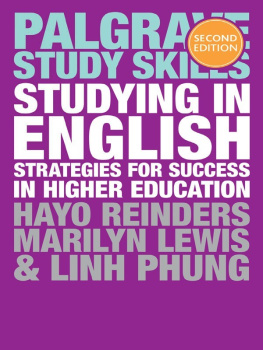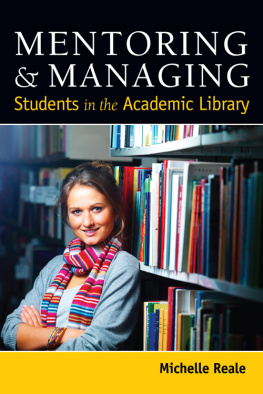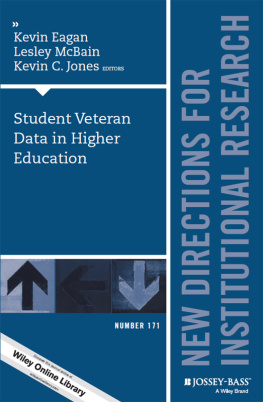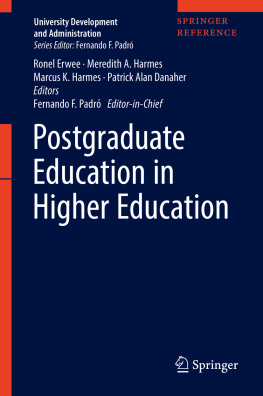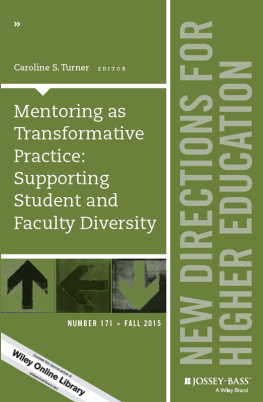About the Author
Buffy Smith , Ph.D., is a sociologist, educator, and consultant. She is an Associate Professor in the Department of Sociology and Criminal Justice at the University of St. Thomas. She earned her B.A. in Sociology at Marquette University and a M.S. and Ph.D. in Sociology at the University of Wisconsin-Madison. The courses she teaches include Social Problems, Race & Ethnicity, Social Stratification, and the Sociology Senior Seminar. Dr. Smiths primary research interests include examining racial and class disparities within the higher education system. She also writes on policy issues dealing with mentoring, access, retention, equity, and diversity in higher education. She has over 10 years of experience researching how colleges and universities can assist underrepresented students with understanding and navigating the institutional culture of higher education in order to achieve academic success. Dr. Smith has received several awards and grants that recognize her research on diversity issues in higher education. Dr. Smiths publications have been featured in research and practice oriented journals such as African American Research Perspectives and Equity & Excellence in Education. She can be reached via email at bsmith@stthomas.edu.
Acknowledgments
I could not have written this book without the loving grace and mercy of God. I was blessed to have a strong supporting network of family and friends during this entire process. I would like to thank Gary Sandefur, Jane Collins, Marino Bruce, Grace Livingston, Julia H. Cradle, Carlotta Calmese, Susan Smith-Cunnien, and Barbara Townsend who have been great mentors and friends to me.
I am indebted to my beloved mother Henreitta Smith, aunts Cora Lockett and Henrine Wilson, late uncle Cleophus Smith, brother Ronald Smith, godmothers Mary Albritton and Debra Skinner, and other relatives and friends for their unwavering love, encouragement, and support. In addition, I am blessed to have a loving and wonderful life partner Sherrie Fernandez-Williams who provided me with insightful feedback on numerous drafts of the book and for keeping me sane during the writing process. She is also a remarkable mentor.
I am extremely grateful to Sandie McNeel for editing my chapters and providing words of encouragement. I would also like to express deep gratitude to all the mentees, mentors, and mentoring program directors who participated in my study. It was an honor to interview you and I learned a lot from each of you. You have all inspired me to become a better mentor.
I want to thank other significant people who have been instrumental in bringing this book to fruition; Stephen Brookfield, Carolyn Holbrook, Priscilla Gibson, Mary Easter, Carla-Elaine Johnson, Latoya Beck, and Aundria Morgan.
Moreover, I am thankful for TRIO Educational Opportunity Programs, Ronald E. McNair Scholars Program, Association for the Study of Higher Education, and the Lumina Foundation for professional development, mentoring, and financial support.
In addition, I appreciate the willingness of both journals African American Research Perspectives and Equity & Excellence in Education for granting me permission to use sections of my previously published articles for this book. Finally, I would like to thank my editors Eric Wrona and Emily Natsios and the great production team at Lexington Books for their patience, expertise, and assistance in producing this book.
Appendix A: Methodology
Recruitment
After the University of Wisconsin-Madison Human Subjects Committee approved my research project, I began the recruiting process in 2001. I initiated a meeting with the director of the Cleophus Mentoring Program. I served as a mentor in this program from 1998-2003. I also met with the director of another mentoring program, The Everlean Mentoring Program. I assured both directors that I was not interested in evaluating the respective programs, rather I was interested in the types of institutional cultural capital and social that were transmitted and acquired within mentoring relationships.1
In order to protect the identity of my respondents I changed their names and any other specific information that could be used to identify them. I also gave pseudonyms for the mentoring programs. The students in the Everlean Mentoring Program had to maintain a minimum of a 3.0 GPA, but there was not a minimum GPA requirement for the Cleophus Mentoring Program. One of the objectives of the Everlean Mentoring Program was to establish strong personal friendships between mentors (faculty and administrators) and students as a means to foster academic success among the students. The Cleophus Mentoring Program encouraged mentors (faculty, staff, administrators and graduate students) to serve as supportive allies to help students feel less isolated on campus as they worked toward their academic goals.
The directors of the mentoring programs matched mentors and mentees based on numerous characteristics such as shared academic interests, hobbies, and other personal attributes (including race and gender) that the directors thought might make the faculty member and student a good match. Both mentors and mentees volunteered to participate in the respective programs, except for the mentees in the Everlean Mentoring Program who were required to participate in the program as one of the stipulations for receiving their scholarship. Mentors and mentees were encouraged to meet on a regular basis (not specifically defined) and to make a two-year (Cleophus) or four-year (Everlean) commitment to participate in the mentoring programs.
After meeting with the two directors, they agreed to assist me with the project by allowing me to post an e-mail advertisement about the study to their membership e-mail listserv. I also placed an advertisement about the study in the faculty and staff newspaper for six weeks and posted flyers at the diversity center on campus. The newspaper ads and flyers indicated that I wanted to interview mentors and mentees for approximately two hours about their mentoring experience. The eligibility requirements were that they had to have participated in one of the targeted mentoring programs for at least one year and had at least three face-to-face meetings with their mentors/mentees. I provided a monetary incentive of $25 to both mentors and mentees.
There was a greater response rate from the mentees than from the mentors. As part of the screening process, I asked the mentees the name of their mentors and invited their matched mentors to participate in the study. The mentors referred to me by their mentees all refused to participate in the study. I did not have a prior relationship with the mentors (lack of social capital). Some of the reasons the mentors provided for declining my invitation for an interview were the following: (1) they could not make a two-hour commitment for an interview; (2) they were not interested in the study; (3) they did not have a positive mentoring experience and they did not want to talk about it; and (4) they did not like to be interviewed and were suspicious of participating in research studies. In fact, all of the mentors in the study, except for one faculty member, were administrators with whom I had developed a close professional relationship with during my tenure as an academic advisor (strong social capital).
Interviewing Process
I conducted interviews with eight mentors (faculty and administrators) and twelve mentees. The mentees included eleven undergraduate students and one law student who started the mentoring program when she was an undergraduate. Each respondent completed a survey at the beginning of the interview. The mentors and mentees provided background information about their race, gender, social class, and parents educational attainment (see Appendix B). The survey also asked mentors and mentees to describe how often they communicated with one another, what types of topics they discussed, and what types of activities they engaged in on a regular basis during their mentoring relationships.


